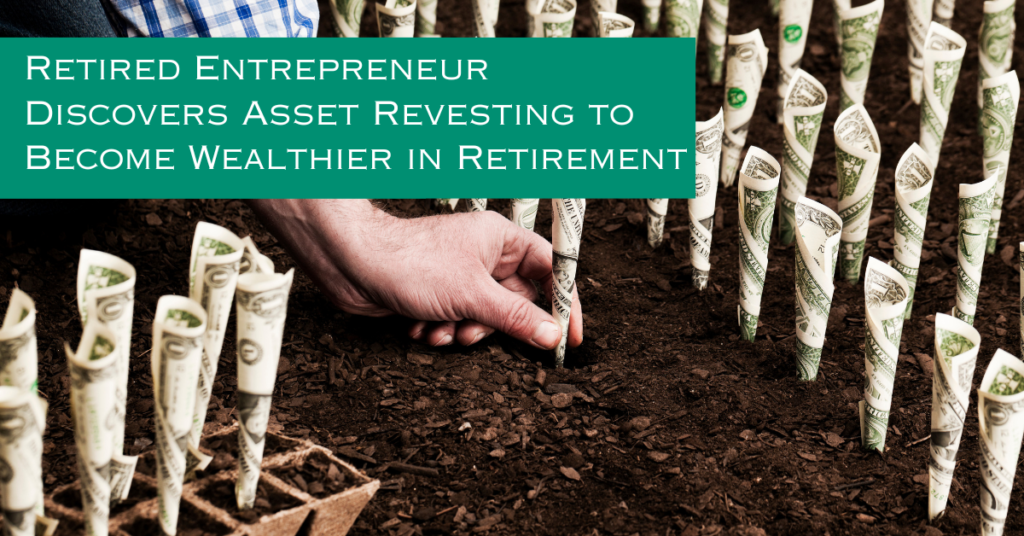Retired Asset Revester

Benjamin is a sixty-eight-year-old retired entrepreneur. Over the course of thirty years, his restaurant became a chain spanning the New England region. Two years ago, he sold the company to spend more time with his wife Nancy, their three children, and their five (and counting!) grandchildren.
Unfortunately, Benjamin’s physical health is deteriorating due to too many years spent working every position in his restaurant. Carrying heavy ingredients, mixing, cooking, managing, and thus being on his feet all day, every day has accumulated into permanent injuries in his feet, ankles, knees, and back.
He wants nothing more than to spend his remaining years relaxing, strolling through the woods surrounding his lovely Vermont home, birdwatching, enjoying barbecues with his entire family, and passing on his love for food and nature to his grandchildren.
Financially, Benjamin’s sole goal is to enjoy his retirement without spending so much that he has nothing to leave behind. His son Gary referred him to a financial advisor many years ago so his money could grow without his active involvement. The financial advisor recommended dividend stocks and told him to reinvest the dividends so that dollar-cost averaging would help him improve his cost basis and increase his gains.
Though not fully understanding the financial terms being used, Benjamin did as the advisor suggested. Some years he did okay, but the losses he suffered from various market setbacks far outweighed the advantages of dollar-cost-averaging. He tried to hang on and wait out the drawdowns, but when his home needed significant repairs, he had to sell some of the dividend stocks and lock in what was, until then, only paper losses.
After losing close to 25% of the value of his portfolio, Benjamin decided that what he needed more than a big win was to avoid a big loss. He wanted to find and focus on an investment strategy that prioritized protecting capital. He did not, however, want to sacrifice returns completely. In fact, Benjamin wanted to be able to rebuild his savings while also implementing strategies that would ensure he never lost that large of an amount again—even in a bear market.
At first, his goals seemed like fantasies…a financial strategy pipe dream. His advisor, friends, and even folks on his internet investment forums laughed at him. Some of them offered what they considered helpful ideas, usually consisting of some weird scammy-sounding “guarantee” or crypto move that sounded like a rug pull. Others told him stories of a friend of a friend of a cousin who hit it big with some stock he’d never heard of. But it all boiled down to the same message – risk big to win big. What he actually heard was risk big to win big to lose even bigger.
But he persisted in his search, and one day, Benjamin saw another investor talking about something called asset revesting. When Benjamin asked him for details, the investor explained that it was a mixture of capital preservation and growth that allowed an investor only to hold rising assets in their portfolio. When the asset began to decline, it was sold. And, sometimes, if there were no suitable assets, the strategy even advised a move to a cash position.
At first, Benjamin was skeptical. He’d always been taught to hold onto assets for the long haul and that staying in cash was one of the worst things to do. But he was also a little intrigued. So he signed up for an asset revesting signal newsletter that promised to tell him when to move in and out of various assets in order to capitalize on imminent rises and prevent losses. The newsletter also practiced risk and position management by giving guidelines for setting protective stops to minimize losses and setting limit orders to help realize profits gradually.
After several months, Benjamin couldn’t believe the difference. He had experienced decades of investing using the traditional methods of diversification, buy-and-hold, and dividend-reinvesting, which caused his portfolio value to gyrate, with some years losing over 30%. Now, with this different, more proactive, and lower-risk strategy, he understood what the other investor was talking about when he said asset revesting was unique. Benjamin saw that when the market took a downturn, an investor’s assets continued to grow in strategic ETFs that showed signs of rising.
Asset revesting turned out to be a perfect strategy for Benjamin’s goals. His money worked for him, growing consistently even during a bear market. At worst, he saw a drawdown of less than -6%, which is where he set his protective stops. This was an incredible difference from the 20-30% drawdowns he had experienced before. He no longer worried about what the remaining years would bring financially. With his growing assets and downside protection, he knew he could enjoy the retirement he had earned and still have a legacy to pass down to his kids and grandkids.
And wouldn’t you know it, but as his financially induced stress lessened and confidence grew, he found the time to care for his body better. Would his aches and pains disappear entirely, no. But when the constant worry, sleepless nights, and fear of the future receded, Benjamin greeted each day with a smile and enough energy to keep up with his grandkids….at least for a little while!
